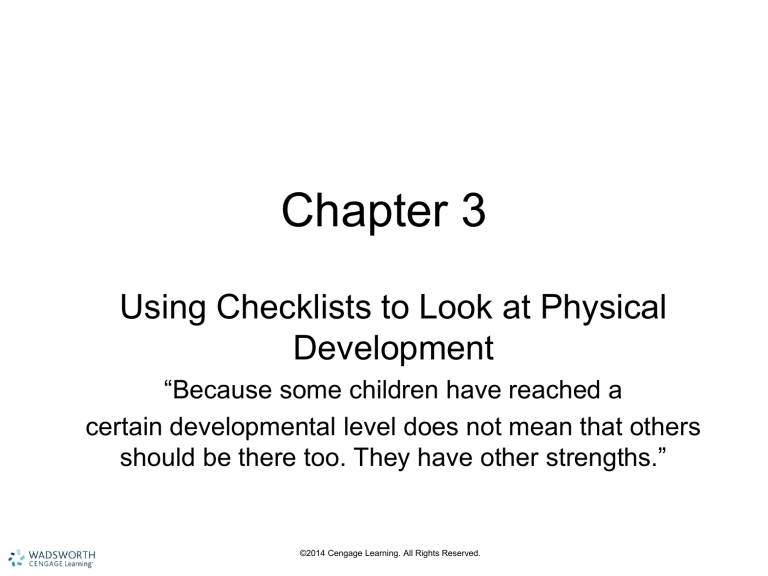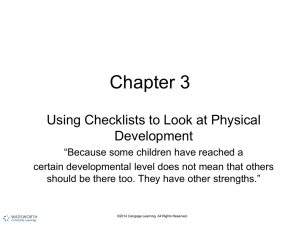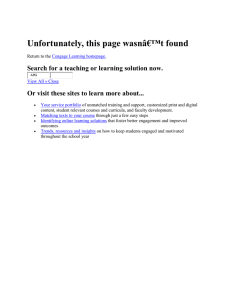Chapter 03R.ppt

Chapter 3
Using Checklists to Look at Physical
Development
“Because some children have reached a certain developmental level does not mean that others should be there too. They have other strengths.”
©2014 Cengage Learning. All Rights Reserved.
CHECKLISTS
• Predetermined list of criteria
• Answers the question “Yes” or “No”
• Closed method
• Records accomplishment of milestones of development
• Gives indicators of the sequence of development
• Shows progress over time
©2014 Cengage Learning. All Rights Reserved.
Uses of the Checklist
Advantages
• Time and labor efficient
• Covers many areas of development
• Individual documentation of each child
• Indicators of development and progress or lags that may be of concern
Disadvantages
• Loses the details of the event
• May be biased or incorrectly rated by the observer
• May not have clearly observable criteria
©2014 Cengage Learning. All Rights Reserved.
What to Do with It
• File in each child’s portfolio/folder
• Use it to plan curriculum in areas not yet attained
• Use it to look further at significant development lags
• Compare to previous recording to see progress over time
• Share with child and family
©2014 Cengage Learning. All Rights Reserved.
TOPICS IN OBSERVATION
Your Frame of Reference
The Frame
• Childhood
• Education/Training
• Past experience with children
• Own learning styles
• Values
Smudges
• Biases for or against the child or the family
• Personal factors that affect observation
©2014 Cengage Learning. All Rights Reserved.
LOOKING AT GROWTH AND
DEVELOPMENT
• GROWTH:
– Changes that can be measured in numbers
• DEVELOPMENT:
– Changes that are qualitative, refined in a predictable sequence
• AFFECTED BY:
– Genetics
– Prenatal care
– Illnesses and accidents
– Environmental factors
– Age, maturation
– Economics
©2014 Cengage Learning. All Rights Reserved.
Physical Growth & Development
• Stages
– Predictable sequence
(the infant first gains control of the head by using neck muscles, then the shoulders) individual timetable
(some infants start walking by 10 months and some by 16m.
• Importance
– Health, cognition, social emotional development, play
• Observing
– Safety
– Environment
– In nature
– Curriculum planning
©2014 Cengage Learning. All Rights Reserved.
Interrelated Factors in
Physical Growth and Development
©2014 Cengage Learning. All Rights Reserved.
Observing the Physical Development of Infants and Toddlers
• Critical for health and safety
– Physical changes as indicators of all development
– Before language, it is through close observation that the caregiver is informed of the child’s health and safety
• New locomotor skills bring opportunities for exploration and learning but also expose the child to new dangers
©2014 Cengage Learning. All Rights Reserved.
HELPING ALL CHILDREN WITH
PHYSICAL DEVELOPMENT
• Physical Development and Culture
• Boys and Girls
• Children with Special Needs
• Helping Professionals
©2014 Cengage Learning. All Rights Reserved.
Standard Related to Physical
Development
• ACTIVE START: A Statement of Physical
Activity Guidelines for Children Birth to
Five. Look at Figure 3 −11 in the text.
• Position: All children birth to age five should engage in daily physical activity that promotes health-related fitness and movement skills.
©2014 Cengage Learning. All Rights Reserved.





